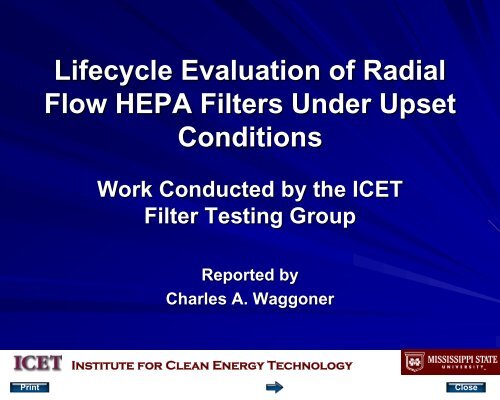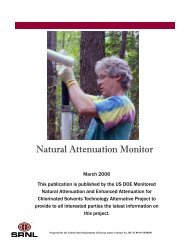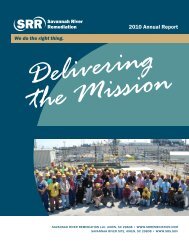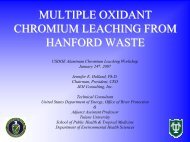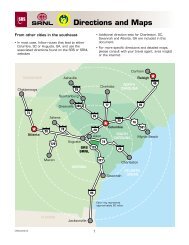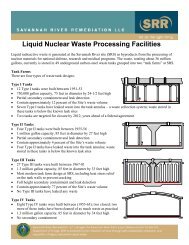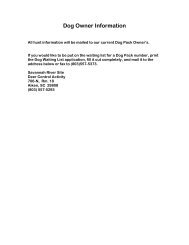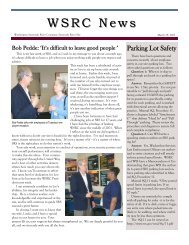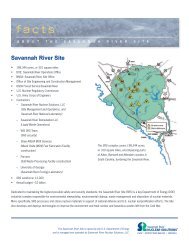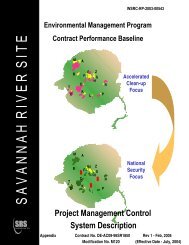Institute for Clean Energy Technology
Institute for Clean Energy Technology
Institute for Clean Energy Technology
You also want an ePaper? Increase the reach of your titles
YUMPU automatically turns print PDFs into web optimized ePapers that Google loves.
Lifecycle Evaluation of Radial<br />
Flow HEPA Filters Under Upset<br />
Conditions<br />
Work Conducted by the ICET<br />
Filter Testing Group<br />
Reported by<br />
Charles A. Waggoner<br />
<strong>Institute</strong> <strong>for</strong> <strong>Clean</strong> <strong>Energy</strong> <strong>Technology</strong>
Radial Flow HEPA Filters<br />
European Experience with Radial Flow Filters<br />
New Standard (2008), AG-1 1 Section FK Radial<br />
Flow Filters<br />
Absence of Qualified Filters<br />
Existing Data<br />
– Dated (1990)<br />
– Limited Particle Size Distribution<br />
– Limited Characterization<br />
DOE 1066 Fire Protection Guidance<br />
2<br />
<strong>Institute</strong> <strong>for</strong> <strong>Clean</strong> <strong>Energy</strong> <strong>Technology</strong>
Project Test Plan Development<br />
ORP Personnel<br />
DOE-HQ Personnel<br />
Han<strong>for</strong>d-RL Personnel<br />
Bechtel Personnel<br />
Dr. Vern Bergman<br />
Sharon Steele, NNSA<br />
Carter Shuffler, DNFSB<br />
ATI-FTF Personnel<br />
Flanders Personnel<br />
3<br />
<strong>Institute</strong> <strong>for</strong> <strong>Clean</strong> <strong>Energy</strong> <strong>Technology</strong>
Testing of Unqualified Filters<br />
Remote Change Filters Deemed Most<br />
Sensitive to Failure During Upset<br />
Conditions<br />
Filter Pack Parameters<br />
Wet Overpressure Testing<br />
ATI FTF Testing 4<br />
<strong>Institute</strong> <strong>for</strong> <strong>Clean</strong> <strong>Energy</strong> <strong>Technology</strong>
Remote Change FK Filters<br />
5<br />
<strong>Institute</strong> <strong>for</strong> <strong>Clean</strong> <strong>Energy</strong> <strong>Technology</strong>
<strong>Institute</strong> <strong>for</strong> <strong>Clean</strong> <strong>Energy</strong> <strong>Technology</strong><br />
6
Filter Housing<br />
Modified to Accept<br />
Either Safe Change or<br />
Remote Change FK<br />
Filters<br />
Houses One or Two<br />
Filters<br />
Sampling Ports<br />
Aerosol Measurement<br />
Velocity<br />
<strong>Clean</strong>-out<br />
Access Panel<br />
7<br />
<strong>Institute</strong> <strong>for</strong> <strong>Clean</strong> <strong>Energy</strong> <strong>Technology</strong>
Single FK Radial Filter Airflow<br />
During Testing<br />
Blind<br />
Blind<br />
Filter<br />
8<br />
<strong>Institute</strong> <strong>for</strong> <strong>Clean</strong> <strong>Energy</strong> <strong>Technology</strong>
Aerosol Injection<br />
Powder<br />
Media<br />
Inlet<br />
Flow-dyne<br />
Critical Flow<br />
Nozzle<br />
24” Test Stand<br />
Nozzle<br />
3” Flange<br />
Flow<br />
Air<br />
Inlet<br />
VACCON<br />
Vacuum Pump<br />
9<br />
<strong>Institute</strong> <strong>for</strong> <strong>Clean</strong> <strong>Energy</strong> <strong>Technology</strong>
Aerosol Measurement Instruments<br />
Upstream<br />
– TSI SMPS<br />
– TSI APS<br />
Downstream<br />
– TSI Laser Aerosol Spectrometer<br />
– ATI Aerosol Photometer<br />
10<br />
<strong>Institute</strong> <strong>for</strong> <strong>Clean</strong> <strong>Energy</strong> <strong>Technology</strong>
Aerosol Challenge Agents<br />
Literature Values of PSDs<br />
Alumina- Al(OH) 3<br />
– MMD 0.3 µm<br />
– Used in previous studies on<br />
filter clogging<br />
– Represents loading by small<br />
– particles<br />
Carbon Black<br />
– MMD 1 – 5 m<br />
– Similar to aerosols used in UK<br />
– studies<br />
– Represents soot from fires<br />
Arizona Road Dust<br />
– MMD 5 µm<br />
– Represents loading by large particles.<br />
dV/dlnD, Voume Fraction<br />
120<br />
100<br />
80<br />
60<br />
40<br />
20<br />
0<br />
Arizona Fine<br />
Carbon Black<br />
Alumina<br />
0.1 1 10 100<br />
Particle Diameter, m<br />
11<br />
<strong>Institute</strong> <strong>for</strong> <strong>Clean</strong> <strong>Energy</strong> <strong>Technology</strong>
Aerosol Neutralization<br />
12<br />
<strong>Institute</strong> <strong>for</strong> <strong>Clean</strong> <strong>Energy</strong> <strong>Technology</strong>
Remote Change Test Matrix<br />
Remote<br />
Change<br />
HEPA Filter<br />
Remote<br />
Change<br />
HEPA Filter<br />
Test Parameters and Guidelines:<br />
Data Set 1<br />
Data Set 2<br />
Test Set 1:<br />
2000 cfm (56.6 m 3 /min)<br />
70-75 0 F (21.1-23.9 0 C)<br />
40-50% RH<br />
Max dP and/or failure<br />
Test Set 2:<br />
2000 cfm (56.6 m 3 /min)<br />
165-170 0 F (73.9-76.7 0 C)<br />
95-100% RH<br />
Max dP and/or failure<br />
Test Set 1:<br />
2000 cfm (56.6 m 3 /min)<br />
70-75 0 F (21.1-23.9 0 C)<br />
40-50% RH<br />
Max dP and/or failure<br />
Test Set 2:<br />
2000 cfm (56.6 m 3 /min)<br />
165-170 0 F (73.9-76.7 0 C)<br />
95-100% RH<br />
Max dP and/or failure<br />
Aerosol #1<br />
0.25 µm<br />
(Alumina)<br />
Aerosol #2<br />
2.0 µm<br />
(Carbon Black)<br />
Aerosol #3<br />
5 µm<br />
(AZ Road Dust)<br />
Filter 1 Filter 2 Filter 3<br />
Filter 4 Filter 5 Filter 6<br />
Filter 7 Filter 8 Filter 9<br />
Filter 10 Filter 11 Filter 12<br />
13<br />
<strong>Institute</strong> <strong>for</strong> <strong>Clean</strong> <strong>Energy</strong> <strong>Technology</strong>
Carbon Black Loaded Safe Change<br />
14<br />
<strong>Institute</strong> <strong>for</strong> <strong>Clean</strong> <strong>Energy</strong> <strong>Technology</strong>
Filter Housing Photos while Loading<br />
3 in dP 10 in dP<br />
20 in dP Rupture dP<br />
15<br />
<strong>Institute</strong> <strong>for</strong> <strong>Clean</strong> <strong>Energy</strong> <strong>Technology</strong>
Ruptured Safe Change Filter<br />
16<br />
<strong>Institute</strong> <strong>for</strong> <strong>Clean</strong> <strong>Energy</strong> <strong>Technology</strong>
CB Loaded Safe Change Filters<br />
17<br />
<strong>Institute</strong> <strong>for</strong> <strong>Clean</strong> <strong>Energy</strong> <strong>Technology</strong>
Pleat Collapse<br />
<strong>Institute</strong> <strong>for</strong> <strong>Clean</strong> <strong>Energy</strong> <strong>Technology</strong>
CB Loaded Remote Change Filters<br />
19<br />
<strong>Institute</strong> <strong>for</strong> <strong>Clean</strong> <strong>Energy</strong> <strong>Technology</strong>
CB Loaded Filters<br />
20<br />
<strong>Institute</strong> <strong>for</strong> <strong>Clean</strong> <strong>Energy</strong> <strong>Technology</strong>
CB and ARD Loading Curves<br />
21<br />
<strong>Institute</strong> <strong>for</strong> <strong>Clean</strong> <strong>Energy</strong> <strong>Technology</strong>
Differential Pressure vs. Time<br />
<strong>Institute</strong> <strong>for</strong> <strong>Clean</strong> <strong>Energy</strong> <strong>Technology</strong>
FE, FE mass, dP vs. Time<br />
<strong>Institute</strong> <strong>for</strong> <strong>Clean</strong> <strong>Energy</strong> <strong>Technology</strong>
Filtering Efficiency and Differential<br />
Pressure vs. Time<br />
<strong>Institute</strong> <strong>for</strong> <strong>Clean</strong> <strong>Energy</strong> <strong>Technology</strong>
Mass Efficiency and Differential<br />
Pressure vs. Time<br />
<strong>Institute</strong> <strong>for</strong> <strong>Clean</strong> <strong>Energy</strong> <strong>Technology</strong>
Stability as Fcn of dP<br />
<strong>Institute</strong> <strong>for</strong> <strong>Clean</strong> <strong>Energy</strong> <strong>Technology</strong>
dP Slope Without Aerosol Challenge<br />
<strong>Institute</strong> <strong>for</strong> <strong>Clean</strong> <strong>Energy</strong> <strong>Technology</strong>
Vokes Filters<br />
28<br />
<strong>Institute</strong> <strong>for</strong> <strong>Clean</strong> <strong>Energy</strong> <strong>Technology</strong>
Filter Pack Sectioning<br />
29<br />
<strong>Institute</strong> <strong>for</strong> <strong>Clean</strong> <strong>Energy</strong> <strong>Technology</strong>
Acknowledgements<br />
Funding <strong>for</strong> this research activity has<br />
been provided by the Department of<br />
<strong>Energy</strong>’s s Office of Environmental<br />
Management under contract number<br />
DE-FC30<br />
FC30-06EW07040.<br />
06EW07040.<br />
30<br />
<strong>Institute</strong> <strong>for</strong> <strong>Clean</strong> <strong>Energy</strong> <strong>Technology</strong>
Equation <strong>for</strong> Calculation of Particle<br />
Density<br />
Concentration of mass can be found by the following<br />
equation :<br />
Which, when rearranged, yields the equation to find<br />
particle density when the aerodynamic particle<br />
diameter is known, such as from an APS.<br />
<strong>Institute</strong> <strong>for</strong> <strong>Clean</strong> <strong>Energy</strong> <strong>Technology</strong>
Empirical Correlations <strong>for</strong> Particle<br />
Density as a Function of Differential<br />
Pressure<br />
The following correlation was arrived at by utilizing<br />
experimental data collected from the filter that was<br />
loaded with carbon black and weighed at intervals of<br />
interest.<br />
This equation allows one to determine the “effective”<br />
particle density of carbon black based on the current<br />
differential pressure. It presents the equation as a<br />
function of the “effective” density that was found <strong>for</strong><br />
carbon black, =0.939g/cm<br />
3.<br />
Where dP is in inches w.c. . and is in g/cm 3<br />
<strong>Institute</strong> <strong>for</strong> <strong>Clean</strong> <strong>Energy</strong> <strong>Technology</strong>
Data <strong>for</strong> Optimization of<br />
Uninterrupted Mass Loading<br />
Curves<br />
Difference in Actual Mass Gained and Predicted (Calculated)<br />
Mass Gained using =0.939g/cm<br />
3<br />
Filter # Mass Gained Predicted Gain % Error<br />
1 (Adjusted) 1066g<br />
(m)<br />
1056g 0.93%<br />
2 874g 879g 0.55%<br />
3 1036g 1030g 0.58%<br />
4 1211g 1196g 1.26%<br />
5 1068g 1070g 0.17%<br />
<strong>Institute</strong> <strong>for</strong> <strong>Clean</strong> <strong>Energy</strong> <strong>Technology</strong>
Filter Disassembly<br />
34<br />
<strong>Institute</strong> <strong>for</strong> <strong>Clean</strong> <strong>Energy</strong> <strong>Technology</strong>
5 x 5 Grid Coupon Dissection<br />
A<br />
B<br />
25 mm<br />
25 mm<br />
• ~ 3 – 4 mm was trimmed from the front and back edges of<br />
each sheet..<br />
35<br />
<strong>Institute</strong> <strong>for</strong> <strong>Clean</strong> <strong>Energy</strong> <strong>Technology</strong>
Photomicrographs of Media<br />
Cross-section<br />
section<br />
36<br />
<strong>Institute</strong> <strong>for</strong> <strong>Clean</strong> <strong>Energy</strong> <strong>Technology</strong>


